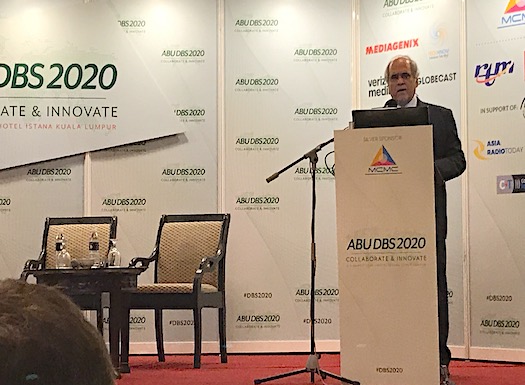“It’s important to reach the audience everywhere on all possible platforms,” said ABU Secretary General Javad Mottaghi, opening this year’s Digital Broadcasting Symposium today in Kuala Lumpur.
“DBS highlights the importance of working together to find solutions to common problems faced by the broadcasting industry. We need to talk together to find effective innovative solutions…
“The Corona virus has derailed many conferences, and many people have not been able to join us due to travel restrictions, but we are glad that we are still able to run this year’s symposium.”
While numbers are understandably down on last year, DBS is still well attended for 2020.
The conference covers radio, television, OTT streaming services and other new broadcast technologies.
In a session looking at the future of Broadcast TV, Peter Siebert from IEEE BTS joked: “Don’t make predictions, but if you have to, put a date so far in the future that you will be dead.”
Traditional tv viewership has stayed constant since 2010, according to Siebert, but time-spent-viewing has dropped. For 16-34 year olds, they spend only about one third of their time watching live broadcast tv, while for the rest of the time they watch non linear video content, often on hand held devices.
“The TV set is still the most used device for watching long form content, from either broadcast tv or streams. People who really want to enjoy content do it on the best device they have, when they can do so, and that is usually a high quality television set.”
“People use their mobile devices, but not for live broadcast content,” he said, quoting European studies which show that shorter streamed video was the most watched on hand held devices such as smart phones and tablets.
He predicts: “Broadcast tv will stay with us, but broadcasters will have to evolve and adapt, while retaining their trusted brand value.”
Fintan McKiernan, CEO of IDEAL Systems, talked about cloud broadcasting, highlighting the benefits as cost reductions, easy deployment, good return on investment and the ability to overcome interoperability issues that are present in hardware systems.
“It is quick and cheap to deploy new services and perfect for spin up channels… The cloud is like a commodore computer, there was no real practical use for it until people started building apps to make it do useful things, that is where cloud computing is up to now.”
Lindsay Cornell, Principal Systems Architect at BBC Digital gave an update on digital radio technical standards.
Radio is mainly about audio, but digital radio also has the ability to deploy text and other content, so the standards aim to make that possible for markets to deploy if they want to in ways that are consistent and will work consistently on many types of receivers.
Text handling issues have been one of the priority areas for digital radio in the past year, with text direction and non Latin scripts being accommodated into the standards. “We have now defined three regional profiles to allow other scripts to be displayed properly.”
Arabic script, which runs right to left, the opposite of Latin script, can now be seen on digital radio screens since the introduction of the new standards. The next issue the standards committee will work on are “combining scripts,” such as Thai, which form letters differently from other scripts (right).
Receiver testing is also necessary to ensure the receiver is able to get all the benefits most efficiently. “Due to the growth of the Indian market we have reviewed the requirements to try and get the best outcomes for the lowest cost… High Level AAC means that some protections are no longer needed, so this element has been removed from the standards.”
For RadioDNS a ‘trusted’ client authentication system has been introduced so trusted sites can be accessed more easily. Geolocation issues have also been updated to protect rights holders.
The committee is also working on a DAB application called ‘filtered information service’ so car manufacturer can deliver targeted messages to the radios of vehicles for recalls, servicing and keeping in touch with customers.

